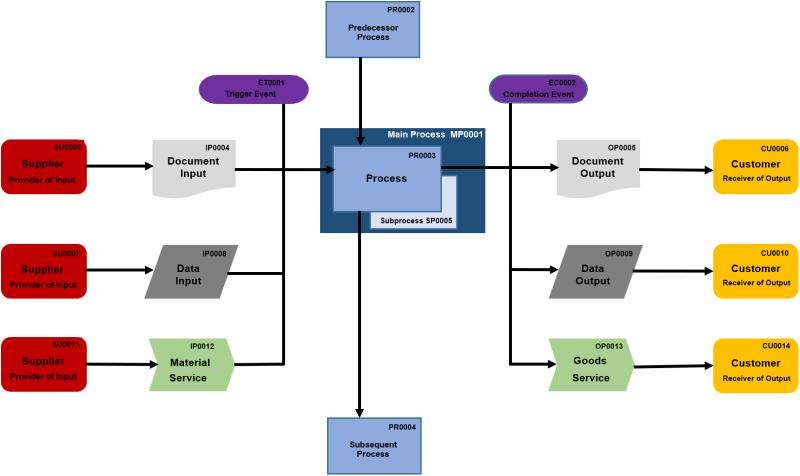SIPOC Process Mapping Benefits for SMEs

Implementing a holistic SIPOC process model with visual end-to-end process maps over three process layers offers a wide range of benefits to small and medium-sized enterprises (SMEs) in their business operations.
SIPOC process & data mapping methodology:
Suppliers (Source) > Inputs (Data & Material) > Process > Outputs (Products & Services) > Customers (Destination)
1. Operational Management
- Efficiency Improvements: SIPOC process maps provide a clear understanding of processes, enabling SMEs to identify and eliminate inefficiencies, leading to streamlined operations and reduced costs.
- Resource Optimization: By visualizing processes, SMEs can optimize resource allocation, ensuring that personnel, time, and materials are used efficiently.
- Performance Monitoring: SIPOC process maps serve as a benchmark for measuring performance, allowing SMEs to set performance metrics, track progress, and make data-driven decisions.
2. Risk and Quality Management
- Risk Mitigation: SIPOC process maps help SMEs identify potential risks at various stages of their processes. This proactive identification enables the development and implementation of effective risk mitigation strategies.
- Quality Control: Detailed process understanding aids in implementing robust quality control measures, ensuring consistent product or service quality. Any deviations from the standard can be quickly identified and rectified.
- Compliance: SMEs can use SIPOC process maps to ensure that processes align with industry regulations and standards, reducing the risk of non-compliance and associated penalties.
3. AI Solution Opportunities
- Data Utilization: SIPOC process & data maps AllinOne generate valuable data about processes. AI algorithms can analyze this data to identify patterns, predict future trends, and provide actionable insights, enhancing decision-making processes.
- Process Automation: AI-driven automation solutions can be implemented based on insights from SIPOC process maps. Repetitive tasks and decision-making processes can be automated, improving efficiency and reducing errors.
- Customer Engagement: AI-powered chatbots and customer service applications can utilize data from SIPOC process maps to enhance customer interactions, providing personalized and efficient services.
4. Strategic Benefits
- Innovation: Understanding processes in-depth allows SMEs to innovate and explore new ways of delivering value to customers, leading to a competitive advantage.
- Agility: With a clear understanding of their processes, SMEs can adapt quickly to changing market demands and trends, ensuring long-term sustainability.
- Customer Satisfaction: Streamlined processes, quality improvements, and innovative solutions ultimately contribute to higher customer satisfaction and loyalty.
5. Succession Planning
- Knowledge Transfer: SIPOC process maps serve as a repository of process knowledge. During succession planning, these maps are invaluable for transferring knowledge from experienced employees to successors, ensuring continuity in operations.
- Skill Development: SIPOC process maps can be used as training tools for developing the skills of potential successors. New employees can learn about processes comprehensively, preparing them for future roles within the organization.
- Process Documentation: SIPOC process maps document processes in a clear and structured manner. This documentation aids successors in understanding the intricacies of operations, enabling a smoother transition.
Explore the smart ProcessHorizon web app for holistic automated process & data mapping AllinONE: https://processhorizon.com

